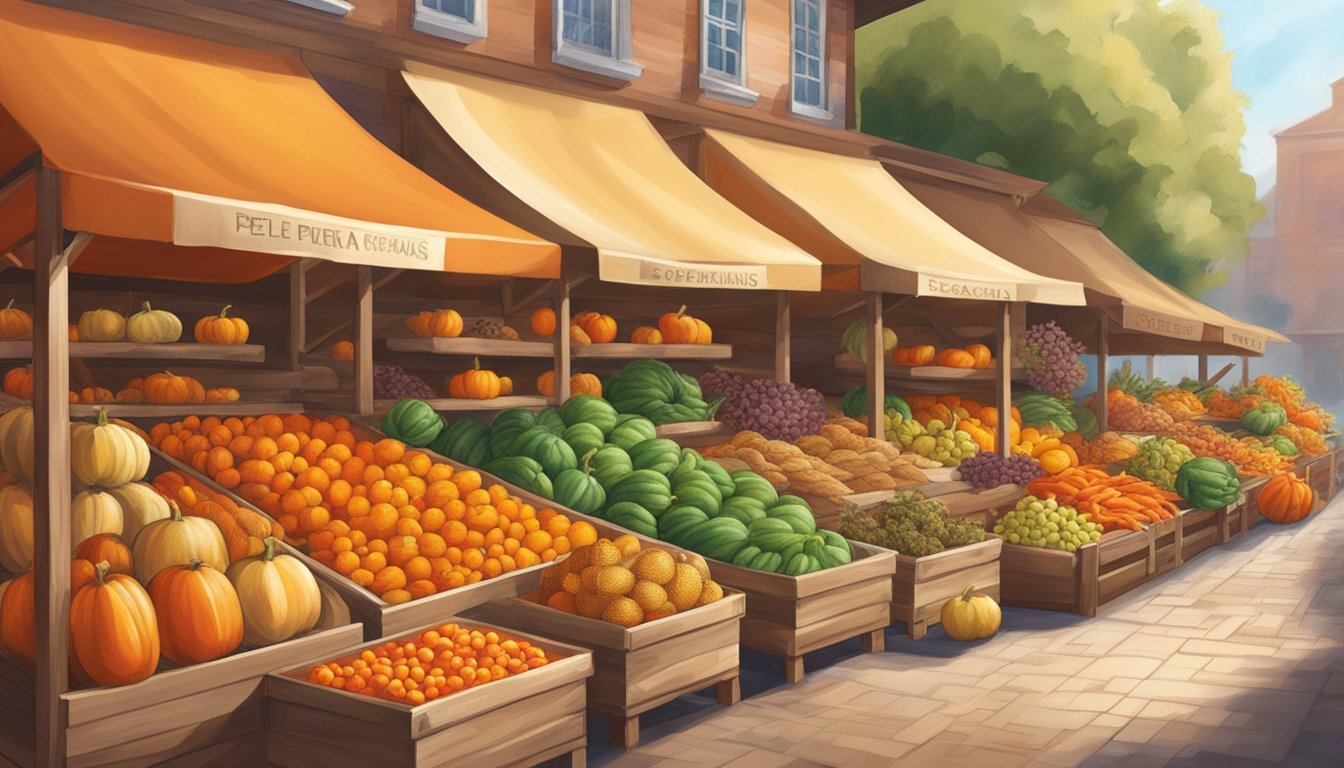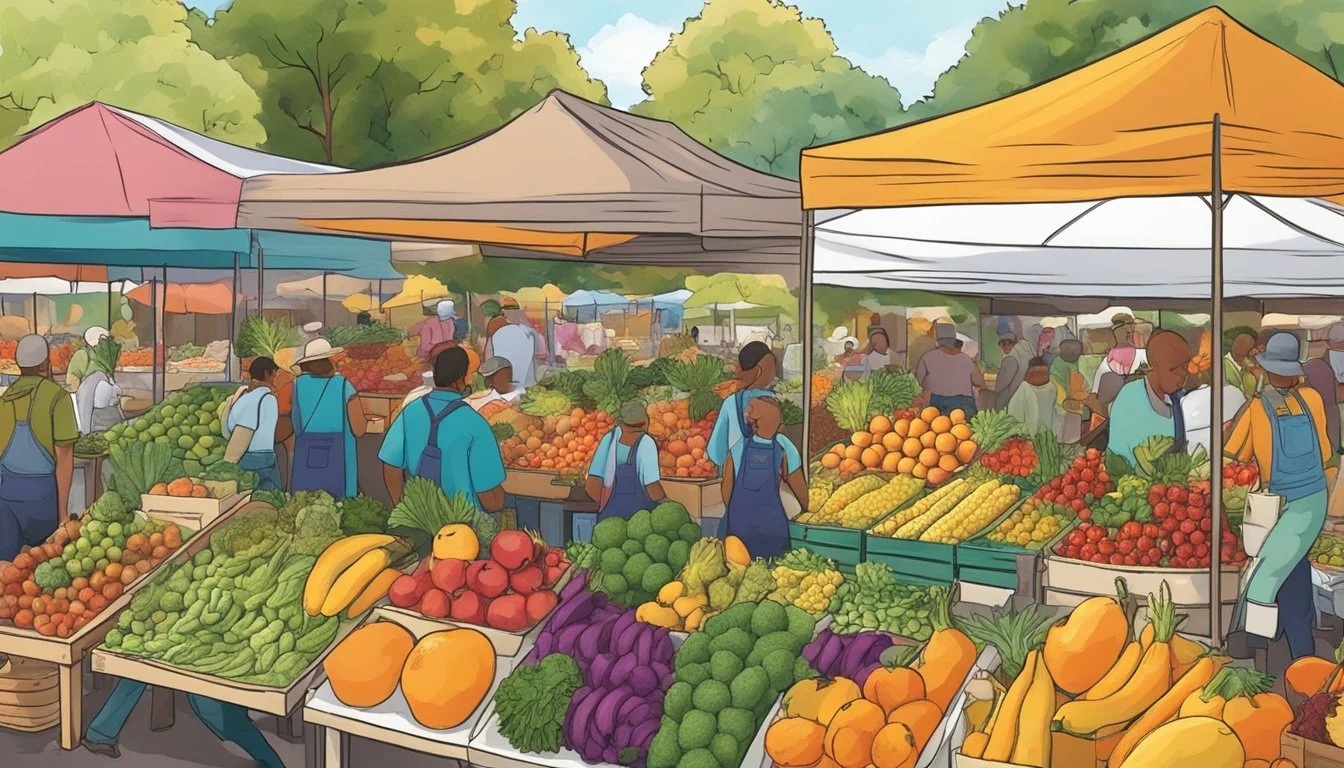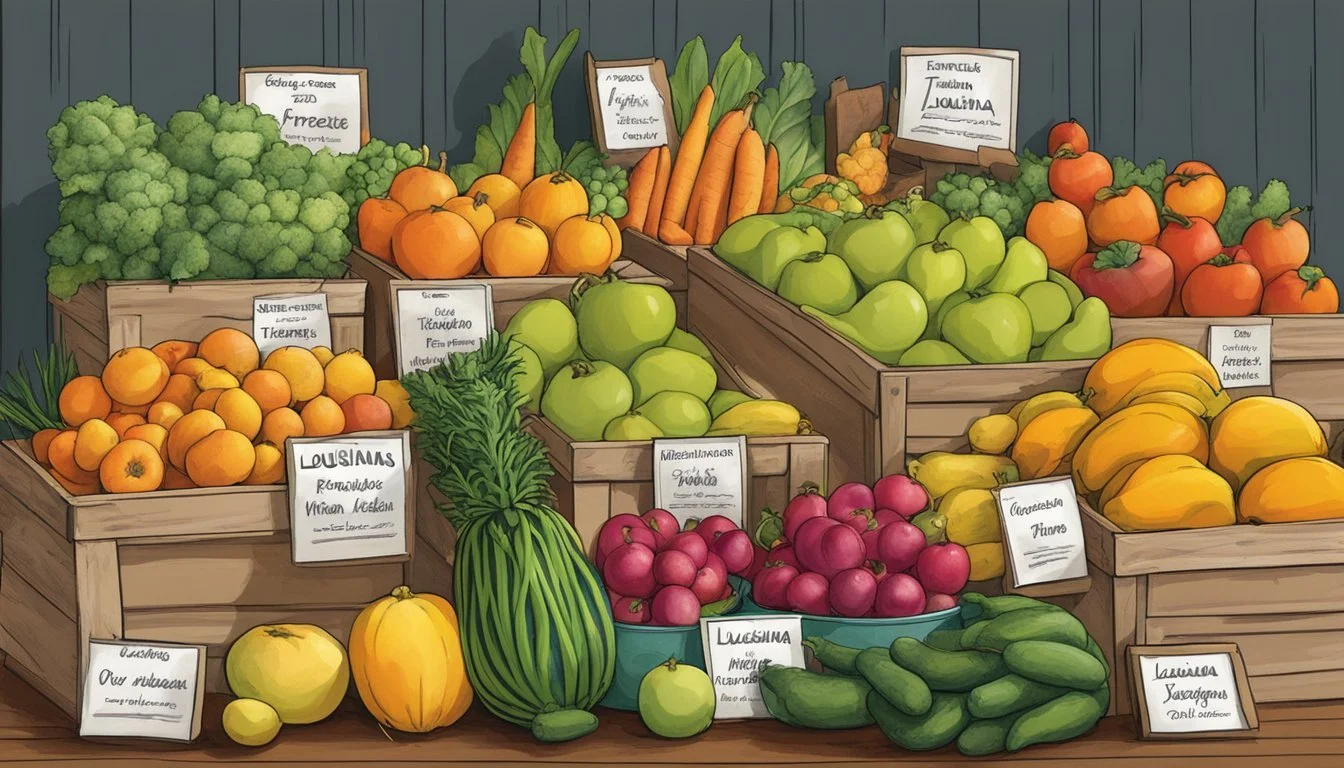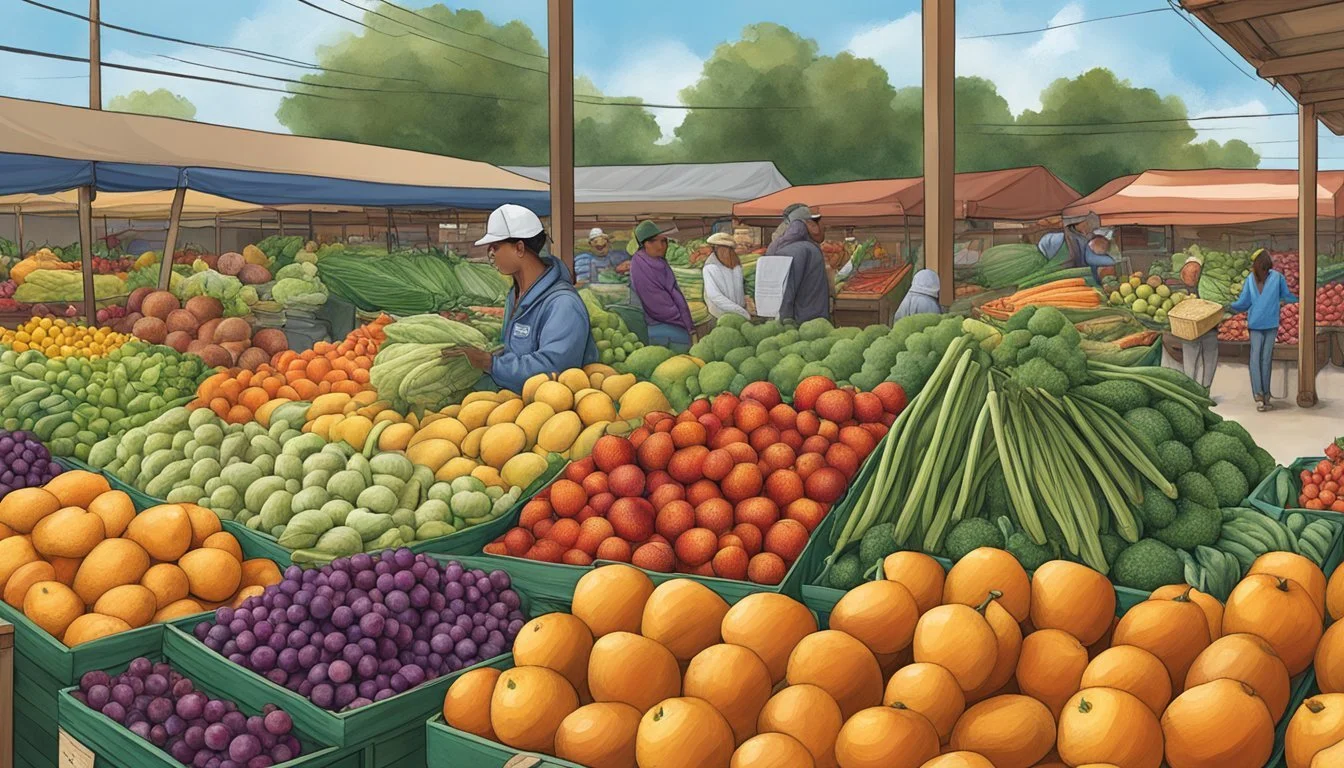Louisiana Seasonal Fruit & Vegetables in November
Your Fresh Guide
This Article is Part of our Louisiana Seasonal Fruit & Veg Calendar
Louisiana's climate offers a unique growing season for a variety of fruits and vegetables, each flourishing at different times of the year. As November arrives, the state's produce selection shifts to embrace the fall harvest. This time of year is particularly notable for the tail end of some summer crops and the peak availability of several cool-weather vegetables. Consumers can expect to find an array of fresh produce harvested within the region.
The vegetable offerings in November are robust, with many root vegetables and greens coming into their prime. Local markets often showcase an abundance of sweet potatoes (What wine goes well with sweet potatoes?), a Louisiana staple, alongside turnips, mustard greens, and collard greens (how long do collard greens last?). These hearty vegetables are well-suited to the cooler temperatures and often form the backbone of traditional southern meals. Meanwhile, in the subtropical zones of the state, a limited selection of fruits is still available, such as the last batches of persimmons and citrus fruits like satsumas, which are just beginning their season.
Louisiana residents and visitors alike benefit from the state's diverse agricultural landscape during November. By focusing on seasonal and locally grown produce, individuals can enjoy fresh, flavorful fruits and vegetables while supporting regional farmers and the local economy. With an emphasis on sustainability and the culinary traditions of the area, Louisiana's November harvest is a true celebration of both culture and agriculture.
Understanding Louisiana's Climate and Seasons
Louisiana's climate significantly shapes its agricultural output, with distinct seasonal patterns influencing when fruits and vegetables reach their peak harvest times.
Impact on Agriculture
Louisiana's agricultural zones are predominantly characterized by a humid subtropical climate. This climate is marked by long, hot summers and short, mild winters. The state receives ample rainfall, which can affect harvest times and crop quality. As a result, farmers must adapt to the climatic conditions to ensure successful harvests, influencing when each season's produce becomes available.
Seasonal Patterns in Louisiana
The state of Louisiana experiences four distinct seasons: spring, summer, fall, and winter. However, due to its southern location, the transition between these seasons tends to be gradual.
Spring: A time of rebirth, where early crops start to flourish.
Summer: Often hot and humid, with intense rainfall that can impact crop schedules.
Fall: Typically milder, allowing for the continuance of harvest but beginning the preparation for colder months.
Winter: Though milder than in more northern states, it impacts what can be grown and harvested during these months.
Crops are planted and harvested according to these seasons, with some fruits and vegetables such as collard greens and select root vegetables being hardy enough to span multiple seasons, while others have shorter, more specific harvest windows.
Seasonal Fruit in Louisiana for November
In November, Louisiana offers a diverse array of fruits with citrus coming into season, berries and subtropical varieties winding down, and some late harvest produce still available.
Citrus Fruits
Louisianans begin to see a bounty of citrus fruits in November. Satsumas, known for their easy-to-peel skin and sweet flavor, are among the most anticipated. Other citrus varieties like Navel oranges and Grapefruits also start to make their appearance, providing a fresh burst of vitamin C as the weather cools.
Satsumas: Peak season
Navel Oranges: Beginning of season
Grapefruits: Beginning of season
Berries and Subtropical Fruits
While the berry season is mostly on its way out, some subtropical fruits, such as Persimmons, can still be found. These fruits are recognized for their unique flavor and are often used in a variety of autumnal recipes.
Persimmons: End of season
Late Harvest Produce
Pomegranates are among the late harvest fruits that continue through November. They are treasured for their jewel-like seeds and are often used in festive dishes or as a colorful garnish during the holiday season.
Pomegranates: End of season
Seasonal Vegetables in Louisiana for November
In November, Louisiana's fields yield a variety of seasonal vegetables, from hearty root crops to leafy greens. These fresh picks are perfect for fall recipes and Thanksgiving menus.
Root Vegetables and Squash
Louisiana's November harvest brims with root vegetables. Staple items like sweet potatoes and turnips dominate the scene. They store well and offer versatility in cooking, being suitable for everything from roasting to making pies. Alongside these, you'll find an array of squash, including pumpkins, which are not just for carving but also for creating hearty soups and desserts.
Sweet Potatoes
Turnips
Pumpkins
Greens and Cruciferous Vegetables
Greens flourish in the cooler November weather. Various types of kale and collard greens are at their peak, offering a nutritious addition to any meal. Cruciferous vegetables such as broccoli and cauliflower (how long does cauliflower last?) also thrive, ready to be steamed, roasted, or transformed into warming soups.
Kale
Collard Greens
Broccoli
Cauliflower
Podded Vegetables and Others
Though the selection narrows as winter approaches, podded vegetables like green beans continue to be available in November. Green beans remain a favorite for casseroles and side dishes during the Thanksgiving season. Additionally, assortments of other vegetables, like bell peppers and onions, are still gathered this month, adding flavor and crunch to dishes.
Green Beans
Bell Peppers
Onions
Preparation and Cooking Techniques for Seasonal Produce
When considering the diverse range of Louisiana's seasonal produce in November, certain preparation and cooking techniques can enhance their flavors and nutritional value. Focusing on roasting, baking, boiling, steaming, and raw preparations, this section explores optimal methods for handling November's harvest.
Roasting and Baking
Roasting and Baking techniques bring out the natural sweetness in vegetables like sweet potatoes and winter squashes. Preheat the oven to between 375°F to 425°F to achieve a caramelized exterior with a tender inside.
Sweet potatoes: Peel, cube, toss in olive oil, and roast for 25-30 minutes.
Winter squashes: Halve, deseed, drizzle with oil, and bake for 45-60 minutes.
Boiling and Steaming
Boiling and Steaming preserve the integrity and flavor of delicate vegetables and are perfect for greens such as turnip, mustard, and collards.
Greens: Wash leaves thoroughly, chop, and boil for 10-20 minutes or steam until wilted.
Turnips and mustard greens: Peeling is optional; dice if boiling, or leave whole if steaming.
Raw Preparations
Raw Preparations capitalize on the fresh, crisp textures and nutrients of November produce. Vegetables like radishes and greens can be used in salads or as garnishes.
Radishes: Slice thinly and serve as a spicy, crunchy addition to salads.
Salad greens: Rinse and pat dry; combine with a simple vinaigrette to let their flavors shine.
Health Benefits of Seasonal Eating
Adopting seasonal eating habits, especially in regions like Louisiana, can have noticeable health and nutritional benefits. This habit ensures that individuals receive peak nutritional value from their produce and supports local agriculture.
Nutritional Profile of Seasonal Produce
Seasonal fruits and vegetables harvested at their prime ripeness often have a higher concentration of antioxidants, vitamins, and minerals compared to those that are out of season and shipped from far distances. For example, Louisiana’s November harvest includes nutrient-dense broccoli and kale, which are packed with vitamins A, C, and K. Similarly, sweet potatoes, a staple in November, come loaded with beta-carotene and fiber.
Encouraging Local Consumption
When consumers prioritize seasonal eating, they inherently support local farmers and the local economy. This practice reduces the carbon footprint associated with long-distance food transport and contributes to community health. Additionally, local produce like Louisiana’s November strawberries tend to be fresher, tastier, and retain their nutritional integrity, as they haven't been subjected to prolonged storage and travel.
Shopping Tips for Seasonal Produce
Shopping for seasonal produce requires knowledge of what’s in season and where to find the highest-quality selections. For Louisiana in November, shoppers will find an abundance of fresh, flavorful vegetables such as cauliflower, celery, sweet potatoes, and various greens.
Finding Local Markets
One can locate local farmers' markets in Louisiana by visiting community websites or using resources such as the USDA’s National Farmers Market Directory. Local markets typically offer a wide range of seasonal produce, and the benefits extend beyond freshness; shopping locally supports area farmers and reduces one’s carbon footprint.
Baton Rouge: Red Stick Farmers Market
New Orleans: Crescent City Farmers Market
Lafayette: Lafayette Farmers and Artisans Market
Farmers' markets often provide the opportunity to speak directly with producers about their farming practices and the characteristics of their products.
Selecting Quality Produce
When selecting vegetables, one should look for vibrant colors and firm textures, signs of produce that's been recently harvested and is at peak ripeness. For example, when choosing sweet potatoes, they should be firm and free of bruises or soft spots.
Sweet Potatoes: Firm, smooth skin without cuts
Cauliflower: Clean, tightly packed florets
Greens (Collard, Kale, etc.): Crisp leaves, rich colors
It is also important to handle produce gently to prevent bruising, considering that bruised areas can spoil more quickly. Shoppers should plan to use delicate items first, such as greens, to ensure consumption at optimal freshness.
The Economic and Environmental Impact of Seasonal Eating
Choosing to eat seasonally has significant economic and environmental implications. Within Louisiana, November's seasonal produce not only supports local farmers but also reduces the environmental challenges associated with long-haul transportation.
Supporting Local Economy
When consumers opt for fruits and vegetables that are in season in Louisiana during November, they are directly contributing to the local economy. Purchasing from nearby farmers' markets and community-supported agriculture (CSA) programs ensures that money stays within the local area. This financial support can lead to job creation and the growth of local agribusinesses.
Economic Benefits:
Money remains in the local community.
Encourages growth of local farms and agribusinesses.
Sustainability and Food Miles
Seasonal eating in November minimizes the environmental impact by cutting down 'food miles' – the distance food travels from production to consumer. The transportation of non-seasonal foods from distant locations consumes more fossil fuels and generates higher levels of greenhouse gases. In contrast, consuming local, seasonal produce results in a smaller carbon footprint and less resource-intensive transportation.
Environmental Benefits:
Reduced greenhouse gas emissions.
Lower consumption of fossil fuels.
Preservation of local ecosystems by minimizing the need for mass production and transportation.
Conclusion
Louisiana's seasonal produce in November highlights an abundance of fresh, flavorful, and nutritious options for consumers. The benefits of choosing seasonal fruits and vegetables include fresher produce with higher nutritional value and support for local farmers.
Bringing It All Together
Residents and visitors in Louisiana have the privilege of accessing a variety of fruits and vegetables during the month of November. This period is characterized by a transition from the fall into the early winter harvest. Some of the compelling reasons to embrace these seasonal offerings include the freshness of the produce, which often translates to a richer flavor profile and a higher concentration of vitamins and minerals.
Moreover, opting for seasonal produce can contribute to environmental sustainability by reducing the carbon footprint associated with transportation of off-season produce from distant locations. It also bolsters the local economy, as purchasing from local farmers markets and grocery stores supports Louisiana's agricultural community.
The list of available produce in Louisiana during November is diverse:
Vegetables
Green Beans
Kale
Fruits
None highlighted in November
Consumers should note that while some items traditionally taper off at this time of year, the state's robust agricultural system ensures variety remains available. The above list is not exhaustive and local markets may offer more based on specific regional harvests.
In summary, embracing Louisiana's seasonal produce in November offers numerous benefits including taste, nutrition, and community support, while the review of available items ensures informed purchasing decisions.







